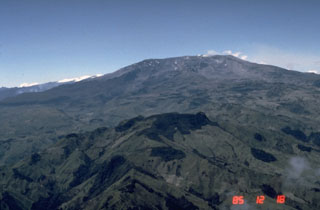Report on Nevado del Ruiz (Colombia) — June 1987
Scientific Event Alert Network Bulletin, vol. 12, no. 6 (June 1987)
Managing Editor: Lindsay McClelland.
Nevado del Ruiz (Colombia) Peak 1987 SO2 emission; seismicity declines
Please cite this report as:
Global Volcanism Program, 1987. Report on Nevado del Ruiz (Colombia) (McClelland, L., ed.). Scientific Event Alert Network Bulletin, 12:6. Smithsonian Institution. https://doi.org/10.5479/si.GVP.SEAN198706-351020
Nevado del Ruiz
Colombia
4.892°N, 75.324°W; summit elev. 5279 m
All times are local (unless otherwise noted)
Low- and high-frequency earthquakes continued at moderate levels after 16 June. Tremor fluctuated but remained weak, reaching a maximum amplitude of 2 mm at the Olleta reference station (4 km W of Arenas crater). The rate of SO2 emission measured by COSPEC reached 5,640 t/d on 17 June, the highest value of 1987. Emission rates then declined to an average of 1,000 t/d for the rest of the month. Little change in deformation was measured.
Geological Summary. Nevado del Ruiz is a broad, glacier-covered volcano in central Colombia that covers more than 200 km2. Three major edifices, composed of andesitic and dacitic lavas and andesitic pyroclastics, have been constructed since the beginning of the Pleistocene. The modern cone consists of a broad cluster of lava domes built within the caldera of an older edifice. The 1-km-wide, 240-m-deep Arenas crater occupies the summit. The prominent La Olleta pyroclastic cone located on the SW flank may also have been active in historical time. Steep headwalls of massive landslides cut the flanks. Melting of its summit icecap during historical eruptions, which date back to the 16th century, has resulted in devastating lahars, including one in 1985 that was South America's deadliest eruption.
Information Contacts: A. Acevedo, INGEOMINAS, Manizales.

